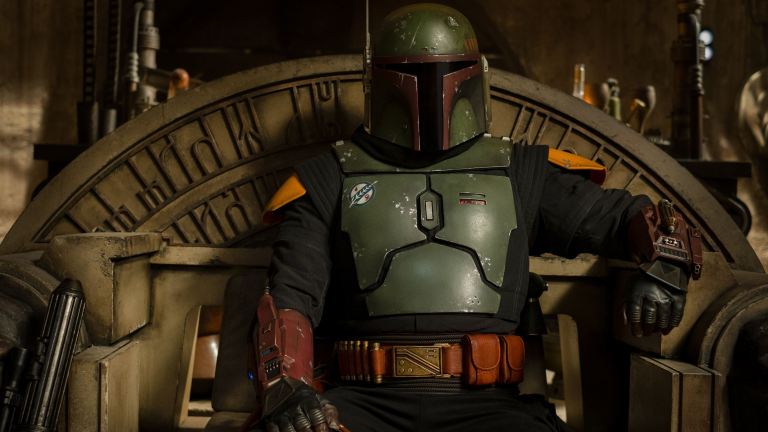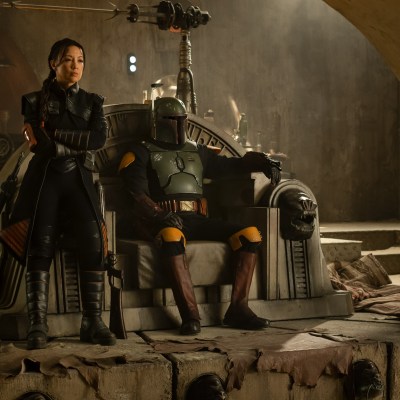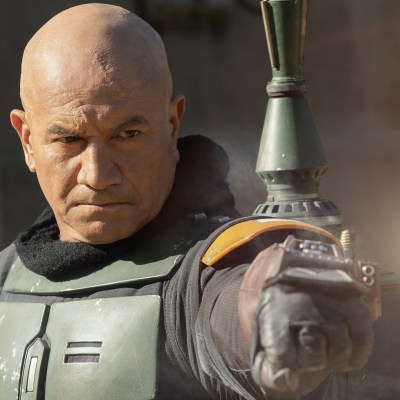Star Wars: The Book of Boba Fett Episode 1 Review: Stranger in a Strange Land
The Book of Boba Fett Chapter 1, "Stranger in a Strange Land," answers some huge questions about the bounty hunter while setting up new ones.

This Star Wars: The Book of Boba Fett review contains spoilers.
The Book of Boba Fett Episode 1
For a while now, December has been Star Wars time. With the movie slate wiped clean, this year’s holiday season premiere is the smaller scale The Book of Boba Fett, which already feels fated for a more niche audience than its loosely affiliated cousin The Mandalorian. Trading in the more universal story of an orphan warrior and his adopted baby for an introduction tied up in a whole host of other Star Wars lore, The Book of Boba Fett‘s competently crafted first episode feels like half a story.
In “Stranger in a Strange Land,” Boba Fett (Temuera Morrison) and Fennec Shand (Ming-Na Wen) start to secure their hold on crime lord Jabba the Hutt’s former territory. Conflict between the two simmers as Fennec advocates that a more violent rule guarantees a stable transition, while Fett works by a code of honor that excludes torture or killing to send a message. No, this isn’t the much colder Fett we met in the Original Trilogy.
But he is scarred by the past. Fett still needs medical treatment for his escape from the acid-filled sarlacc pit, which provides some framing for flashbacks to his childhood and recent history. In the present, a visit to introduce themselves to the local criminals is interrupted by ninja-like assassins, who Fett and Fennec narrowly defeat. It’s a fight that sends Fett right back into the bacta tank for one last flashback to his time with the Tusken Raiders leading to an abrupt cut to credits. It’s an episode that almost doesn’t have a plot, and certainly not a conclusion.
That said, there’s clearly a lot of potential in this era. The Book of Boba Fett takes place five years after Return of the Jedi, and just after the end of The Mandalorian season two. The Republic, including Luke Skywalker and Leia Organa, are working on rebuilding their government. (Tatooine, though, isn’t part of it.) Ben Solo, a.k.a. Kylo Ren, is four years old. There are decades between this show and the Sequel Trilogy, which means it can maintain the feeling of Original Trilogy Lite while pulling on strings from a half dozen pieces of tie-in media. So far, it’s maintained a little bit of The Mandalorian‘s universality simply by not defining its timeline. On Tatooine, after all, the events of the wider galaxy don’t really matter.
It’s worth noting that the episode, directed by Robert Rodriguez and written by Jon Favreau, sets itself apart with its understated diversity. Morrison draws on his Maori heritage for the character’s fighting style, and Wen is neither sexualized nor portrayed as exotic. These are low bars that Star Wars has gotten better at clearing lately, but in a franchise with a history of femme fatales and lifting concepts directly from other cultures, her very neutrality is notable. (Speaking of lifting, Fett’s new title, “Daimyo,” is straight from the age of the samurai.)
Despite the actors gamely working through dialogue that is itself often pared-down and whispered in secret, the central relationship feels underdeveloped but bursting with potential in classic Star Wars fashion. Both Morrison and Wen perform admirably and look great, but the episode’s numerous flashbacks often get in the way of developing their partnership, which at times does show hints of complexity. Fennec feels indebted to Fett because he saved her from what would otherwise have been a deadly wound, but the episode also implies that she would do things differently if she were the crime lord. It’s clear that she enjoys the power that comes with being Fett’s right hand. But ultimately, they’re hard-hearted colleagues.
Part of why the episode feels like it’s half finished is because the conflict between Fett and Fennec hasn’t ramped up. From what we’ve seen so far, life on Tatooine is hard. Honor among thieves exists, but it’s rough honor. (Note the grudging respect paid to Boba by the Tuskens, who, after some humanizing moments in The Mandalorian, are back to being incomprehensible raiders here.) It’s still far, far up in the air whether Boba’s or Fennec’s strategy is more likely to work. Maybe the episode would have felt more complete had those lines been drawn a bit more. (We do know that the Trandoshan gang is going to return, and it looks likely that the local governor will make an appearance, too.)
But I’m torn on how much good will to give Star Wars shows that thrill mostly because of recognition (“Hey, is that the Lars outpost? … No.”) and questions about what will happen next week. Where to draw the line between “this looks lavishly produced” and “there is a story here to tell”? Made using a highly impressive LED dome to cast digital images around practical sets, the settings are alternately beautifully metallic or painterly. The action lacks clarity, not lingering long enough to show off the actors’ good work. A rooftop chase uses its space better than a street fight does, providing the thrill of a good obstacle course. And the music by Ludwig Göransson is distinct, varied and even a little catchy. Along with a versatile theme motif for Boba, Göransson’s score also includes vocals this time around.
The Mandalorian also started out playing by the rule of cool before bringing in more thematic elements of parenthood, religion, and interplanetary politics. And there’s nothing wrong with the rule of cool, either…when it works. There’s geeky pleasure in seeing the inside of the sarlacc pit, with its goop and its heartbeat. But in other places, the cool…doesn’t land.
This episode’s big fight sequence isn’t actually the one with the assassins: it’s a battle between a six-limbed sand monster and Fett that looks weightless and goofy, retro without the charm. Other moments are more grounded. Look at the chain dragging along through the sand, or the opening shots of Boba in the bacta tank. Reminiscent of Darth Vader but containing a man determined not to rule by fear, that first scene makes a powerful opening statement in a conversation about how Star Wars talks about bodies and assistive devices that doesn’t really follow through.
I was skeptical of the beginning of The Mandalorian, too, which I ended up adoring. It’ll be interesting to see how “Stranger in a Strange Land” looks in retrospect. But for now, the fact that it seems to lean on easter eggs over plot is a bad sign for a beautifully realized new Star Wars show.


